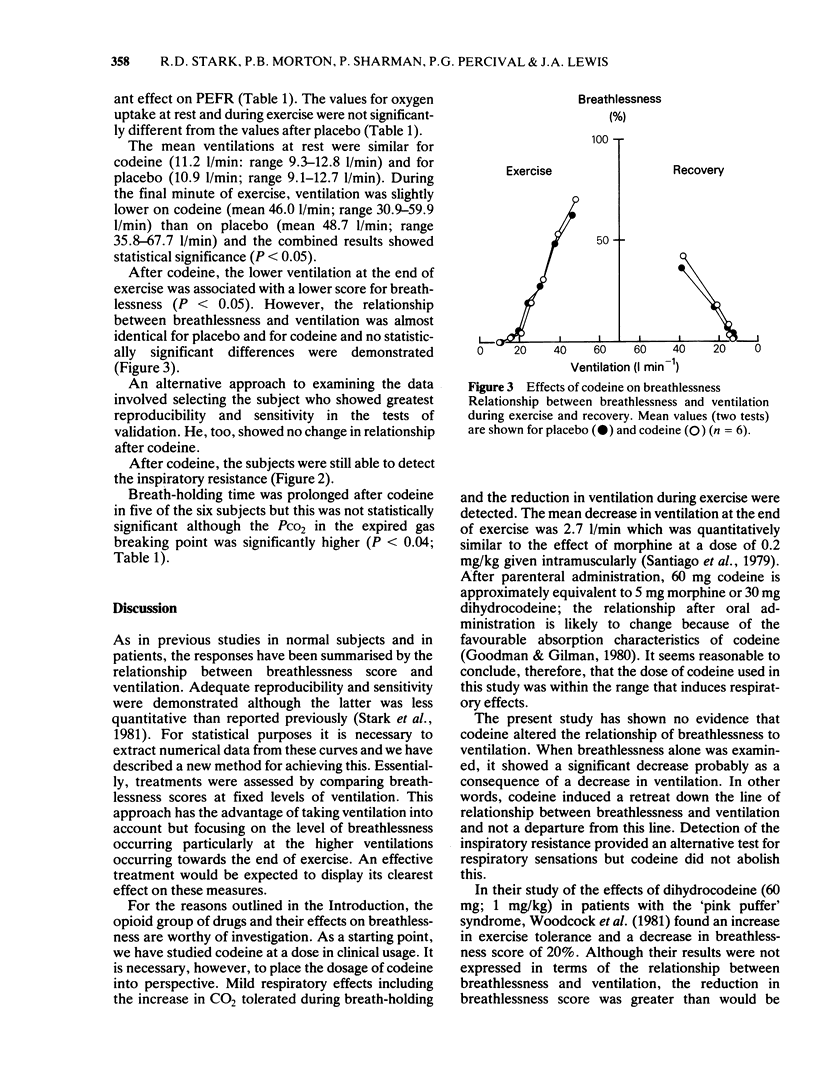Abstract
In six healthy subjects, respiration and the sensation of breathlessness were assessed during submaximal exercise and the subsequent recovery. The overall responses were expressed by the relationship of breathlessness to minute volume. Because of the high subjective component in the assessments, validation of the method in these particular subjects was an integral part of the study. The relationship of breathlessness to ventilation during identical periods of exercise was highly reproducible and sensitivity was demonstrated by an alteration in this relationship in the presence of an inspiratory resistance. Codeine at a dose of 60 mg by mouth was compared with placebo, each treatment being given on two occasions. The study was conducted in a double-blind fashion with randomization of the order of treatments. Codeine at this dose allowed higher levels of carbon dioxide to be tolerated during breath-holding; oxygen uptakes at rest and during exercise were unaffected. Ventilation and breathlessness at the end of exercise were each slightly but significantly reduced by codeine but the relationship between breathlessness and ventilation was not changed. Codeine did not prevent detection of an inspiratory resistance.
Full text
PDF




Selected References
These references are in PubMed. This may not be the complete list of references from this article.
- Puchelle E., Aug F., Zahm J. M., Bertrand A. Comparison of nasal and bronchial mucociliary clearance in young non-smokers. Clin Sci (Lond) 1982 Jan;62(1):13–16. doi: 10.1042/cs0620013. [DOI] [PubMed] [Google Scholar]
- Santiago T. V., Johnson J., Riley D. J., Edelman N. H. Effects of morphine on ventilatory response to exercise. J Appl Physiol Respir Environ Exerc Physiol. 1979 Jul;47(1):112–118. doi: 10.1152/jappl.1979.47.1.112. [DOI] [PubMed] [Google Scholar]
- Santiago T. V., Remolina C., Scoles V., 3rd, Edelman N. H. Endorphins and the control of breathing. Ability of naloxone to restore flow-resistive load compensation in chronic obstructive pulmonary disease. N Engl J Med. 1981 May 14;304(20):1190–1195. doi: 10.1056/NEJM198105143042002. [DOI] [PubMed] [Google Scholar]
- Stark R. D., Gambles S. A., Chatterjee S. S. An exercise test to assess clinical dyspnoea: estimation of reproducibility and sensitivity. Br J Dis Chest. 1982 Jul;76(3):269–278. [PubMed] [Google Scholar]
- Stark R. D., Gambles S. A. Effects of salbutamol, ipratropium bromide and disodium cromoglycate on breathlessness induced by exercise in normal subjects. Br J Clin Pharmacol. 1981 Oct;12(4):497–501. doi: 10.1111/j.1365-2125.1981.tb01256.x. [DOI] [PMC free article] [PubMed] [Google Scholar]
- Stark R. D., Gambles S. A., Lewis J. A. Methods to assess breathlessness in healthy subjects: a critical evaluation and application to analyse the acute effects of diazepam and promethazine on breathlessness induced by exercise or by exposure to raised levels of carbon dioxide. Clin Sci (Lond) 1981 Oct;61(4):429–439. doi: 10.1042/cs0610429. [DOI] [PubMed] [Google Scholar]
- Timmis A. D., Rothman M. T., Henderson M. A., Geal P. W., Chamberlain D. A. Haemodynamic effects of intravenous morphine in patients with acute myocardial infarction complicated by severe left ventricular failure. Br Med J. 1980 Apr 5;280(6219):980–982. doi: 10.1136/bmj.280.6219.980. [DOI] [PMC free article] [PubMed] [Google Scholar]
- Woodcock A. A., Gross E. R., Gellert A., Shah S., Johnson M., Geddes D. M. Effects of dihydrocodeine, alcohol, and caffeine on breathlessness and exercise tolerance in patients with chronic obstructive lung disease and normal blood gases. N Engl J Med. 1981 Dec 31;305(27):1611–1616. doi: 10.1056/NEJM198112313052703. [DOI] [PubMed] [Google Scholar]


